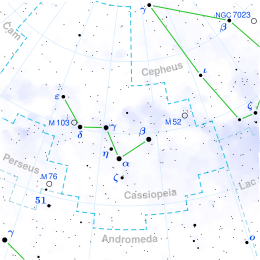HD 19275
HD 19275| 관측 데이터 Epoch J2000.0 이쿼녹스 J2000.0 | |
|---|---|
| 별자리 | 카시오페이아 |
| 우측 상승 | 03h 11m 56.27016s[1] |
| 탈위임 | +74° 23′ 37.1670″[1] |
| 겉보기 크기(V) | 4.85[2] |
| 특성. | |
| 스펙트럼형 | A2Vnn[3] |
| U-B색지수 | +0.05 |
| B-V색지수 | +0.035±0.006[2] |
| 아스트로메트리 | |
| 방사 속도(Rv) | 11.9±3.1km[2]/s |
| 적정운동(μ) | RA: +13.895[1]mas/yr Dec.: -86.168mas[1]/yr |
| 시차(시차) | 19.9554 ± 0.1695 마스[1] |
| 거리 | 163 ± 1 리 (50.1 ± 0.4 pc) |
| 절대치수(MV) | 1.32[2] |
| 세부 사항 | |
| 미사 | 1.80+0.32 −0.29[4] M☉ |
| 반지름 | 2.7[5] R☉ |
| 루미도 | 27.27[2] L☉ |
| 표면 중력(log g) | 4.20±0.25[4] cgs |
| 온도 | 8,875±1,000[4] K |
| 금속성 [Fe/H] | −0.11±0.26[6] 덱스를 만들다 |
| 회전 속도(v sin i) | 시속 250km[7] |
| 나이 | 71+317 −60[4] Gyr |
| 기타 지정 | |
| 데이터베이스 참조 | |
| 심바드 | 자료 |
HD 19275는 카시오페이아 북쪽 별자리에 있는 단일[9] 별이다.흰색 빛깔을 띠며 육안으로는 4.85의 겉보기 시야로 희미하게 보인다.[2]HD 19275까지의 거리는 시차 측정을 사용하여 측정한 163광년이다.[1]그것은 약 12 km/s의 방사 속도로 태양으로부터 더 멀리 떠내려가고 있다.[2]
이 물체는 A형 주계열성으로 별 분류는 A2Vnn이다.[3]'nn' 접미사는 빠른 회전으로 인한 스펙트럼 내 흡수선(광범위한)을 나타낸다.그것은 250 km/s의 예상 회전 속도로 회전하고 있는데, 이것은 별에게 극 반지름보다 15% 더 큰 적도의 불룩함을 주고 있다.[7]이 물체는 태양 질량의 1.8배[4], 태양의 반지름의[5] 약 2.7배인 7100만[4] 년으로 추정된다.유효온도 8,875K로 광권으로부터 태양의 27배에[2] 달하는 광도를 방출하고 있다.[4]
참조
- ^ a b c d e f Brown, A. G. A.; et al. (Gaia collaboration) (August 2018). "Gaia Data Release 2: Summary of the contents and survey properties". Astronomy & Astrophysics. 616. A1. arXiv:1804.09365. Bibcode:2018A&A...616A...1G. doi:10.1051/0004-6361/201833051.이 소스에 대한 가이아 DR2 기록 VizieR.
- ^ a b c d e f g h Anderson, E.; Francis, Ch. (2012), "XHIP: An extended hipparcos compilation", Astronomy Letters, 38 (5): 331, arXiv:1108.4971, Bibcode:2012AstL...38..331A, doi:10.1134/S1063773712050015, S2CID 119257644.
- ^ a b Cowley, A.; et al. (April 1969), "A study of the bright A stars. I. A catalogue of spectral classifications", Astronomical Journal, 74: 375–406, Bibcode:1969AJ.....74..375C, doi:10.1086/110819.
- ^ a b c d e f g Gullikson, Kevin; et al. (2016), "The Close Companion Mass-ratio Distribution of Intermediate-mass Stars", The Astronomical Journal, 152 (2): 40, arXiv:1604.06456, Bibcode:2016AJ....152...40G, doi:10.3847/0004-6256/152/2/40, S2CID 119179065.
- ^ a b Pasinetti Fracassini, L. E.; et al. (2001), "Catalogue of Apparent Diameters and Absolute Radii of Stars (CADARS)", Astronomy & Astrophysics (Third ed.), 367 (2): 521–24, arXiv:astro-ph/0012289, Bibcode:2001A&A...367..521P, doi:10.1051/0004-6361:20000451, S2CID 425754.
- ^ Gáspár, András; et al. (2016), "The Correlation between Metallicity and Debris Disk Mass", The Astrophysical Journal, 826 (2): 171, arXiv:1604.07403, Bibcode:2016ApJ...826..171G, doi:10.3847/0004-637X/826/2/171, S2CID 119241004.
- ^ a b van Belle, Gerard T. (March 2012), "Interferometric observations of rapidly rotating stars", The Astronomy and Astrophysics Review, 20 (1): 51, arXiv:1204.2572, Bibcode:2012A&ARv..20...51V, doi:10.1007/s00159-012-0051-2, S2CID 119273474.
- ^ "HD 19275". SIMBAD. Centre de données astronomiques de Strasbourg. Retrieved 2019-12-16.
- ^ Eggleton, P. P.; Tokovinin, A. A. (September 2008), "A catalogue of multiplicity among bright stellar systems", Monthly Notices of the Royal Astronomical Society, 389 (2): 869–879, arXiv:0806.2878, Bibcode:2008MNRAS.389..869E, doi:10.1111/j.1365-2966.2008.13596.x, S2CID 14878976.



